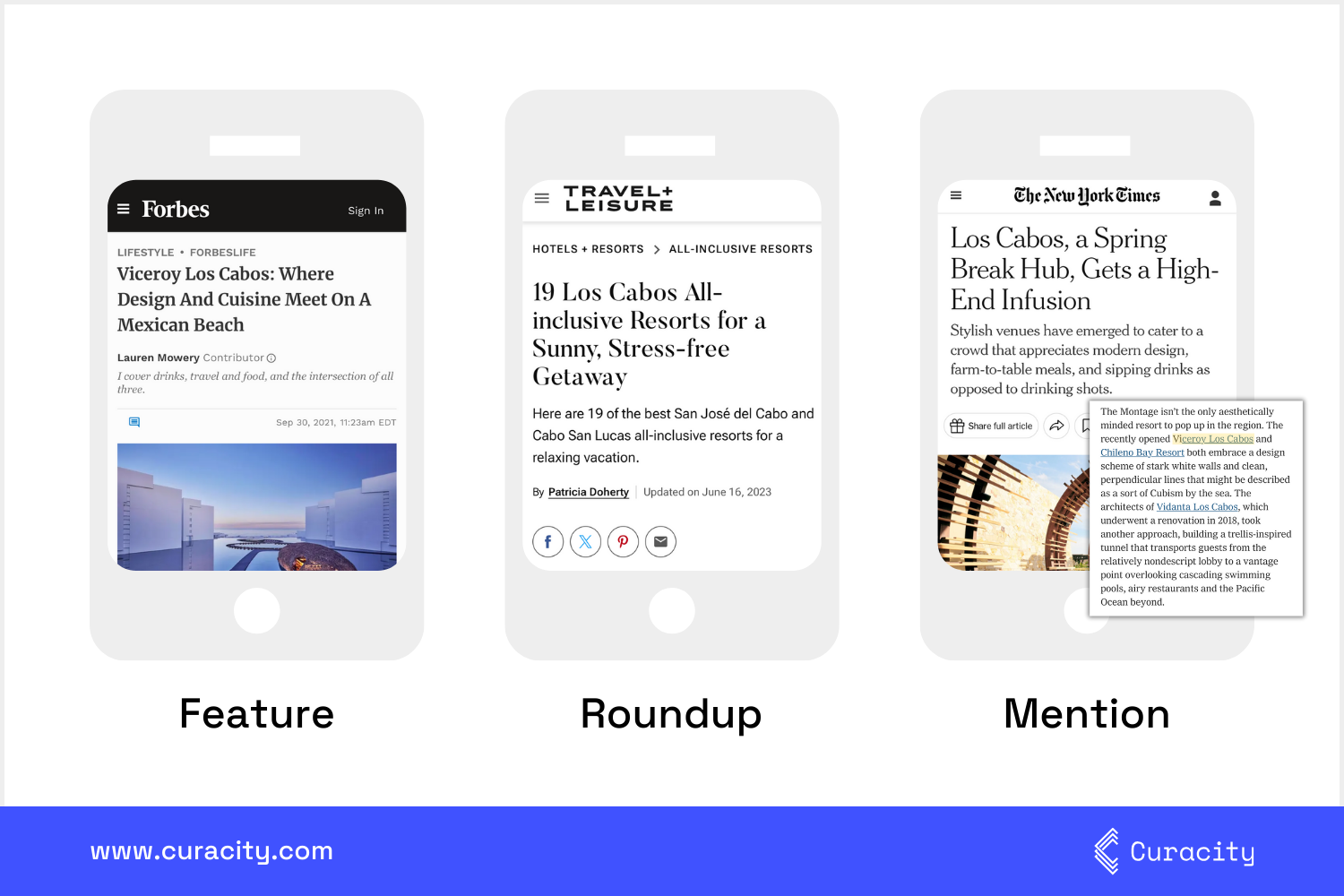Hotel PR professionals face many challenges when securing media coverage.
Not only is there saturation in the media landscape overall, but competition within the hospitality space is fierce. Thousands of properties are vying for attention in a limited number of top-tier media outlets. And the journalists and editors working at those coveted sites receive hundreds of pitches daily, making it incredibly difficult for hotels to break through the noise.
So, what's the future for hotel PR? Read on to learn why the media landscape has shrunk, the scarcity of news hook opportunities, and why traditional PR struggles to measure their work – and the key to navigating these challenges in 2024.
First, what is earned media for hotels?
It's important to understand that not all coverage is created equal. You can read more about earned media coverage for hotels, but for this story, you need to know:

- Media Mention: A brief acknowledgment or reference to your hotel in an article. It's often a passing reference that doesn't provide in-depth information. While it offers credibility by associating the hotel name with the media brand, it doesn't provide the information potential guests need to book a stay. For example, "Kerry Washington attended an event at Hotel Acme on October 15. The actress wore Versace."
- Roundup: A compilation of hotels, sometimes in the same market and other times across various destinations. Roundups provide short blurbs about your hotel, but you're up against other competitors in your market and competitor destinations, too.
- Feature Story: A more in-depth, comprehensive narrative that deeply explores an individual hotel. It goes beyond the surface and often includes the first-person experiences of the journalist or editor. Feature stories are powerful tools for building a narrative and creating a solid image for the hotel, but they're the most difficult to secure.
Why is the media landscape shrinking?
The decline in print newspaper and magazine circulation became more pronounced in the 2000s with the rise of the internet. As readership habits shifted to computers and smartphones, the media landscape adapted — and also shrunk. According to the United States Census Bureau, the number of newspapers and magazines in circulation has contracted by 50% between 2002 and 2022.
Fewer top-tier publications mean fierce competition for a limited number of feature stories in top-tier media outlets such as Condé Nast Traveler and Travel + Leisure. While hotel PR professionals still strive for these placements, they must rely on less authoritative online-only sites and travel blogs to secure the bulk of their coverage, including roundups and cursory media mentions.
The shift to digital and subsequent shrinking media landscape has led to a quantity-over-quality approach, where traditional PR often shows value through the number of media mentions rather than the content quality.
While media mentions may technically keep the hotel's name in the news, they don't provide enough context to convince potential guests to book a stay.
Why are news hook opportunities limited?
Generating timely and relevant news hooks is challenging for hotels. The media wants to feature a hotel when it opens or gets a designer renovation. But what happens when the pre-opening buzz dies down — or no famous architect, chef, or interior designer is tied to the project?
Creativity in finding newsworthy angles is essential. Many hotel PR professionals suggest big-name partnerships or celeb-packed events. Unfortunately, this places a heavy burden on the hotel (or costly third-party event planning services) to constantly refresh the hotel's narrative with new and noteworthy offerings and happenings.
While partnerships and events are another way to get the hotel's name out there, it often results in yet another cursory mention that lacks the information potential guests search for when booking a stay, like amenities, facilities, and location.
Do genuine relationships still matter?
PR professionals once measured their value by the size of their rolodex. While it's true that relationships with journalists and editors offered better chances at securing the most coveted earned media placements, the shrinking media landscape also means there are fewer media members to pitch.
Many publications have a small editorial staff handling hundreds of daily pitches, SEO needs, and advertiser concerns. Having a genuine relationship with a journalist or editor no longer carries the weight it once did, especially when ongoing hotel PR stories often need more relevance, timeliness, and significance to resonate with the audiences of the best media outlets.
Of course, hotel PR professionals with solid relationships have the best chance of being the first to know about the most relevant opportunities for your property. But with so many factors dictating which hotels get the few feature placements available, who you know is no longer the most crucial factor.
What will the rise of pay-for-play mean for PR?
Traditionally, earned media has been the cornerstone of successful PR, relying on the merit of a story to capture the attention of journalists and editors. However, in recent years, the landscape has shifted towards pay-to-play models, where hotels pay for branded or sponsored content, disrupting the hotel PR paradigm.
While pay-to-play models offer a more direct route to visibility (and better reporting on true reach and engagement offered by the media brand), moving away from authentic content placements hurts credibility and resonance with the target audience.
The rise of pay-to-play models poses the challenge of authenticity. Audiences are becoming increasingly discerning, and transparent, genuine content is more critical than ever.
Why can’t PR measure ROI?
The complex travel planning journey makes measuring the impact of traditional PR nearly impossible.
According to Google, the average travel planning journey includes over 7,000 digital touchpoints over four months, encompassing 534 Google searches and 1,400 Google Street View, Maps, and other image views.
The lifetime of a tracking cookie (often used for monitoring and tracking online behavior across different websites and over time) is 30 days. With the average consumer spending several months planning their trip, PR has historically struggled to prove how their earned media placements result in downstream bookings.
With the demise of tracking cookies in 2024 (Curacity co-founder and CEO Nick Slavin recently covered the topic), establishing the impact of PR on non-linear travel planning will remain a challenge.
So, what’s next for hotel PR?
Adaptability and strategic foresight are indispensable in the dynamic hotel PR landscape in 2024. Overcoming these hurdles demands continuous innovation and a commitment to presenting hotels in new, compelling ways. By embracing technology, hotels can not only navigate the shifting tides of PR but also leverage them to their advantage, ensuring sustained visibility, credibility, and engagement in an ever-evolving media landscape.
Curacity can help.
Over 500 properties have used Curacity's proprietary technology to earn $500MM+ by automating the distribution of tailored hotel content to AFAR, Condé Nast Traveler, Travel + Leisure, and many more outlets on its media brand network.
Learn more about how the Curacity platform works for hotels and talk to us to learn how Curacity can generate incremental revenue for your property.
